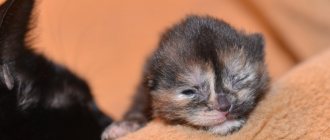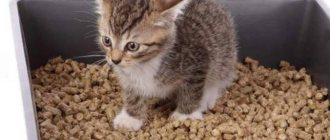Home » Useful Information
With the arrival of a kitten in the house, a new, exciting and full of exciting life begins. But many people don’t even imagine how much trouble the breeder expects and how much effort he makes to ensure that a healthy and strong pet comes into the house. How do babies develop under the supervision of a cat mother and a human when they begin to take their first steps?
- 2 When kittens start walking
2.1 How a kitten learns to walk
- 2.2 Video: a kitten’s first steps at three weeks
Cat skeleton
The cat has a truly unique skeleton. It is light, flexible and incredibly strong, and consists of an average of 250 bones.
The most amazing thing about the skeleton is that the cat is the only mammal that does not have a collarbone. More precisely, it is represented by only two bones, which are not attached to the shoulder joint and are not responsible for any functions. The shoulder blades are connected to the spine by muscles, ligaments and tendons, which is why the animal is able to crawl into any gap - as long as its head passes through. The cat's front paws have amazing elasticity, which provides the animal with the ability to make easy and safe jumps and a comfortable landing.
The hind legs and sacrum of the cat, unlike all other bones, are fixed into a reliable and durable structure, thanks to which the hind part of the skeleton is able to withstand enormous loads
The hind legs have a different purpose. They are attached rigidly to the pelvis. The bones of the pelvis and hind legs are longer and much better developed than the front ones. At the same time, the metatarsal bones are more massive, since their purpose is jumping. Having this structure, cats can move very quickly in any direction: up and forward. They are excellent tree climbers and sprinters.
Another feature of the musculoskeletal system is that cats are digitigrade animals, that is, they walk on tiptoes. This provides them with a quiet and smooth gait and also gives them an advantage in speed: when running, the cat does not fall on loose surfaces such as sand.
Having such a stunning skeleton, cats have unsurpassed ability to move. That is why it is very important to pay special attention to the development of the kitten from the first days of life.
Expert advice
Veterinarians and experienced felinologists advise animal lovers who decide to get a kitten to do the following:
- Once pregnancy is established, the cat is switched to premium dry food or higher and is provided with sufficient food.
- At 2 weeks the baby's incisors erupt, and from three weeks the animal can chew granulated food. From this moment on, kittens are given dry food. By the age of two months, the cat's mouth will be armed with twenty-six teeth.
- For the safety of the babies, they are given a special playpen for kittens.
- The area around the cat's den is covered with carpet.
- Before the babies get stronger and begin to leave the nest, dangerous objects are removed.
Be sure to read:
Puberty in cats: signs, when it occurs, optimal age for mating
If the kitten is injured, call a veterinarian. You cannot hesitate, otherwise the cub will die or become disabled. Transport to a hospital may worsen the injury. The cat is kept motionless until the doctor appears.
What problems are possible?
A good breeder, or simply the owner of a cat who has become a mother, will closely monitor his pets. It is necessary to observe how the kittens develop. Weak babies need special care, because it is more difficult for them than others to get to their mother, to warmth and milk. It is worth paying attention to kittens that by the third week do not fully stand on their paws; during these attempts they squeak loudly or refuse to walk at all. These symptoms are a serious reason to consult a veterinarian.
Weak legs, pain and other manifestations of discomfort can be a symptom of both congenital and acquired pathologies. Congenital pathologies that prevent you from starting to walk fully include diseases such as:
- kidney diseases of various etiologies;
- hip dysplasia;
Hip dysplasia manifests itself as a discrepancy between the pelvic cup and the head of the femur.
- rickets;
- various types of tumors;
- defects of the musculoskeletal system and spine.
If signs of discomfort appear in a healthy kitten, then we can assume that the baby has received an injury, the severity of which must be determined by a doctor.
It is worth noting that some cat breeds are more susceptible to hip dysplasia than others. These are breeds such as:
- Maine Coon;
- British;
- Scottish Fold (Scottish Fold);
The Scottish Fold breed is prone to hip dysplasia
- Persian;
- Siamese;
- Norwegian forest;
- Devon Rex;
- Abyssinian (the so-called subluxation of the patella is noted);
- Burmese;
- chartreuse;
- exotic shorthair.
Therefore, when purchasing kittens of these breeds, it is necessary to check the documents that indicate whether the baby is free from this disease (the pedigree usually contains marks if this pathology was present in the baby’s family). But at the same time, we must remember that this disease manifests itself only by six months and you should not neglect observations from a doctor.
At the age of one and a half months, kittens are already playing actively, running very fast, jumping a lot, climbing vertical surfaces, as soon as they catch their claws. They eat on their own and know what a tray is. At this age, the baby is ready to move to a new home.
Breeders of different breeds donate kittens no earlier than they are 3 months old. By this time, the first vaccination has already been completed, and the baby is psychologically independent.
Developing life skills in kittens.
Until two weeks of age, the cat practically does not leave the kittens. The cat begins to leave them for a more or less long time only 2-3 weeks after their birth. At the same time, the kittens begin to climb out of their box, exploring the territory. At this time, it is already necessary to ensure that nothing threatens them (they do not fall from an accidental push, etc.), and the toys are safe.
The most difficult for kittens are the first two months of life. They do not yet have experience and cannot foresee the danger posed by such familiar things as falling plates, a vacuum cleaner, doors (unexpectedly opening or, conversely, slamming shut), not to mention truly dangerous things - thunderstorms, cars, dogs (alas, and people!) and so on. Silence should not be artificially created; kittens should be able to navigate in normal noise conditions. It is advisable that children play with kittens under adult supervision. All acquired skills will help the kittens adapt to their future independent life. Each kitten up to 7 weeks of age should be given 30-40 minutes a day. At this time, you need to comb him, play with him, talk to him, hold him in your arms - this will give him the skills to coexist with people. In addition, kittens learn by imitating a cat. They learn to fear what the cat fears.
How to protect a kitten starting to walk on its own
Newborn kittens should be handled very carefully. Take it in your hands carefully: the entire body should fit completely into the palm. You cannot squeeze the kitten or make sudden movements. The height of the fence inside which the babies live should be such that the kitten cannot accidentally climb over it. This could result in serious injury or death.
The family should be placed where the floor is non-slip. When the kittens begin to walk, it is necessary to remove all wires and ropes from their reach, and tie up the curtains so that there is no temptation to climb on them and tear off the curtains. It should be borne in mind that cats are very flexible animals and can crawl anywhere, so you need to carefully examine the room for narrow holes and hidden places.
When entering a new home, the baby experiences enormous stress: there is no mother, no brothers and sisters, no familiar smells. All this frightens the kitten very much, and he will definitely seek refuge. Therefore, you should not immediately disturb him or include him in an active game.
If there are small children in the house, then they need to be explained that the kitten should be treated gently: do not push the baby, do not pull the paws, do not frighten or chase. You need to pick up the baby carefully and carefully, holding him firmly and over a soft surface such as a bed or sofa. It's even better to just sit with him, taking him on your lap. The child must strictly observe all these measures. After all, the kitten is very nimble, nimble, and its claws are very sharp, and in an effort to get out, it can scratch the child, and he, in turn, will simply drop it.
The nuances of caring for a kitten
When the baby gets stronger, becomes curious, and begins to explore the world around him, he needs to be warned against trouble. All dangerous objects are removed from places where the cubs roam.
When the baby gets stronger, becomes curious, and begins to explore the world around him, he needs to be warned against troubles.
Kittens can get stuck in narrow places on furniture, secluded corners behind sofas, cabinets, get tangled in curtains, cling to the tablecloth and drop dishes on themselves.
The cat should not be pulled by the paws or kicked.
Slippery floors are especially dangerous. A child who gets angry can jump onto a smooth surface and damage a tendon or joint. Healthy cubs do not squeak when walking and do not limp. If something bad happens, your pet needs to be shown to a veterinarian.
The kitten should not be placed on a closet or sofa.
His ligamentous apparatus is underdeveloped, the bones have not formed. Instinct makes him jump off. This leads to injury. At the age of one month, babies play pranks, jump on their sisters and brothers, watch their mother, and try to imitate. By observing the cat's behavior near the feeder, babies become accustomed to eating solid food.
Six to eight week old pets are ready for independent living. At this time, the owner decides what to do with them - keep them, put them up for sale or give them to friends.
At this point, a responsible owner of kittens will vaccinate the pet against viral diseases, having previously treated it against worms and fleas.
How many times do kittens go to the toilet?
If the kitten has not gone to the toilet on day 5, then you can try to stimulate it; to do this, you need to insert a small piece of baby soap into the pet’s anus.
If a kitten has difficulty passing stool, then it is necessary to reconsider the animal’s diet; maybe it lacks fiber or does it consume a lot of milk? You can use ready-made food specially designed for babies, or you can try giving porridge with ground boiled meat.
There is no clear answer to the question of how many times kittens go to the toilet; this process depends on various factors: how often the animal drinks water, what it eats, what its emotional state is.
At the initial stage of introducing complementary foods to kittens, problems may arise related to the individual characteristics of the functioning of the digestive tract of animals:
- constipation;
- diarrhea;
- excretion of feces mixed with blood and poorly digested food.
You can try adding a small amount of Vaseline oil to your baby’s food, massage the tummy and monitor for 1-2 days.
If bowel movement does not occur after the manipulations performed, the pet must be urgently shown to a veterinarian to identify the cause and effectively solve the problem.
6–7 months: puberty
At 6–7 months, cats finish changing their teeth. The permanent incisors grow first, then the canines. The process of puberty is actively underway. Pets may become restless, some begin to mark their territory. During this period, hormonal levels change and animals may show aggression. If a pet tries to bite or scratch its owner, such attempts must be stopped.
The weight of a cat at 6–7 months reaches 2.4–.6 kg. Externally, the animals look like adult cats. They have developed hunting instincts, their movements become smooth and graceful. In the autumn-winter period, young cats undergo their first molt. Animals should be brushed regularly to prevent hairballs from forming in the stomach.
When does a baby first stand on its paws?
Kitten tries out his paws at 2 weeks of age
In general, the development of kittens of all breeds is the same. However, some experienced breeders find a difference and say that this happens differently in different breeds. Girls are usually 1-2 days ahead of boys in development, and short-haired breeds develop slightly faster than long-haired ones. In total, the kitten will try to stand on its paws when it is 10-14 days old, and will fully stand and run in about 20 days.
If the development of a kitten is noticeably delayed compared to the rest of its litter or differs from the general framework, you need to contact a veterinarian. The development of the kitten in the first month determines its entire future life. A specialist will help correct nutrition or other causes of developmental delay.











